Every time I crossed it, I always wondered what lies behind the grand fortifications of Kangra fort in Himachal Pradesh but somehow never found the answer before. Located in Kangra, a popular district in Himachal Pradesh in India, Kangra fort is believed to be the oldest dated fort in India. Stories of it being haunted had often reached my ears but I shirked them away as folktales. However, I always wondered how the largest fort in the Himalayas would look from inside.
We never made the trip in all these years as I was advised that it was not well maintained and was not suitable to explore with a kid. But this time when we visited Dharamshala, we got to know that ASI had renovated Kangra Fort and it was open for business. The history buff inside me leaped with joy and we decided to do a day trip to Kangra fort with family.
History
Kangra fort is located about 20 kms from Dharamshala and just outside Kangra town. The history of the fort is fascinating. It is said to have been built during the Mahabharata ages around 4th century BC by the royal Rajputs of the Katoch Dynasty of Kangra. The fort was very prosperous with its immense wealth hidden in 21 wells built within the complex. This led to many invasions by the rulers of the neighboring states and foreign lands. The treasures of Kangra fort were plundered by Mahmud Ghazni in 1009, Firuz Shah Tughluq in 1360 and Sher Shah in 1540. Ghazni looted eight of the twenty one wells and the British in the 1890s found five more wells. So if the locals are to be believed, there are still eight more wells inside the fortress that are full of treasure waiting to be discovered.
There is a famous saying in Himachal, “He who holds the fort, holds the mountains”. Many dynasties tried to gain control over Kangra fort in Himachal Pradesh. In the next set of centuries, the Katochs went to war against the Mughals, Gurkhas and the Sikh army to defend their lands and their fort. Even though Kangra fort slipped out of the hands of the Katoch family a couple of times, they did manage to win it back.
Kangra fort defended itself against more than 50 attacks but had to surrender to its fate of abandonment after a terrible earthquake destroyed significant parts of the fort and the palace in 1905.
Visiting Kangra Fort
Visiting Kangra Fort in Himachal Pradesh is a unique experience. Ascending the steps of the fort, you will soon realise the beauty of its offering, a perfect mix of history and nature. Sitting off a cliff in the lap of the Dhauladhar mountain range, the structure of the fort is the main reason for its high defensiveness. The layout of the fort has very cleverly taken advantage of nature around it, to build up its natural defenses using the mountains. With a single entrance, the winding stairs are narrow with mountains and ramparts on either side to guard the way up to the palace that was located on the top of the hill once upon a time.
The entrance is a multi-level courtyard with manicured lawns with an ancient water tank and a small room in ruins in a corner. My audio guide tells me that this lower section of the fort was where the garrison and barracks for the soldiers were, however, nothing survives other than some parts of the hammam. As I made my way towards the fort, it reminded me of the Golconda fort in Hyderabad. Built on the same principle, the architecture of Kangra fort allows only one entrance to the fort. The winding path upwards passes through many gates before it even reaches the top courtyard which used to house the royal palace, the living quarters and the prosperous temples.
The Gates of Kangra Fort
Every gate of the fort has a story behind it. The fort has a total of 11 gates and 23 bastions. The first gate known as the Ranjit Singh Gate was built by Maharaja Ranjit Singh of Punjab who wanted to celebrate his victory over the majestic fort. He added another gate named after him to further strengthen the defenses of the fort.
“You must pass through the gate leg first, never lead with your head because if there’s an enemy on the other side, you might lose your head,” said his grandfather to Tikaraj Aishwarya Katoch, the current heir of Katoch dynasty, one of the oldest surviving royal dynasties of India. The audio tour of Kangra Fort provided by ASI is quite informative and shares many such small anecdotes.
The next gates are the Ahini gate, Jahangiri Gate and Andheri gate. As you pass Ahini gate, you will see adjoining structures and bastions that were used as a lookout position by the soldiers. On the way you can see the Katoch crest, a black buck with a flying scarf tied to its neck. On one side is the engraving of Lord Ganesha and on the other side is Goddess Ambika, the clan goddess of the Katoch family.
A couple of steps ahead you will see the image of Lord Hanuman and Lord Ganesha. on the wall that extends to the next gate, Jahangari gate. This gate was built by Jahangir, the Mughal emperor, to commemorate the victory of Mughals on Kangra fort. The ramparts on the side give a panoramic view of the valley and the Dhauladhars. We stopped to catch our breath and enjoy the serenity.
The next gate is called Andheri gate and it used an interesting tactic against the enemies. The passageway leading to it is narrow and was covered by tall walls on both sides such that sudden darkness fell upon on anyone trying to cross it. For the enemies, this was a moment of confusion, as they would wait for their eyes to get adjusted and by the time they realised what was upon them, it was too late.
The remains of the temples
The next gate with statues of Goddess Ganga and Yamuna on either side welcomes you into the large courtyard. The sight of the ruins is bound to make you wonder how grand the view would have been when the magnificent temples would have stood in all their glory. The L shaped structures on the right side look like rooms however some of them are in shambles. Crossing the courtyard, a flight of steps goes above to what would have been the palace once upon a time. But before you move ahead do spend some time amidst the temple ruins and who knows what secret you may unravel.
The glory of Kangra Fort was not just because of its strategic position and wealth but also due to its temples. Himachal Pradesh is also known as devbhoomi, the land of gods. The temples of Kangra Fort in Himachal Pradesh were famous across the lands. The temple of Goddess Ambika inside the fort is considered to be the oldest Ambika temple in India. The nearby chiefs and devotees had through the centuries offered costly gifts and jewels to the temples leading to the accumulation of a lot of wealth in the royal treasury. My guess is the grandeur of the temples would have reflected its stature.
But unfortunately, years of looting and finally the devastating earthquake has destroyed significant parts of the temples. Today what stands as a reminder of those majestic times are the pillar bases, broken carved pillars, temple walls and remains of the stones that once supported the temple.
While the three main temples, the Ambika mata temple, Laxmi Narayan temple and a Jain temple are no longer there, there is a simple temple just next to the stairs that is still in use. The sound of chanting and bhajans just added to the ambiance and made it more magical. I reminded myself that there is more to see and started climbing the stairs up to the highest point in the fort.
Midway, my audio guide nudged me to look down and I got an amazing view of the back of the Laxmi Narayan temple. I realised my guess was right. The intricate carving on the back of the temple in the Shikhara style does remind of greater times when all the temples would have been in their prime.
On top of Kangra fort
The last gate is known as Mahal darwaza or Palace gate and opens to the palace courtyard. There are railings to guard the courtyard that offers spectacular panoramic views of the snowcapped mountains. The platform houses a large underground water tank in the middle and a few ruined structures. But what captivated my imagination was how amazing it would have been to live in a fancy palace with such breathtaking views. I took a pause sitting at the bench allowing myself to soak in a bit of everything, the history, the beauty and the calmness. But just like for every mother, my break was short-lived as my son reminded me that our adventure for the day was over and it was time to get back home.
Looking for more ideas about traveling through Himachal Pradesh? Read here to plan a road trip through the state.






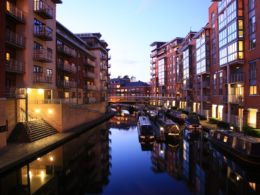








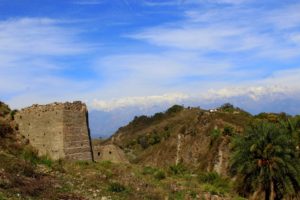
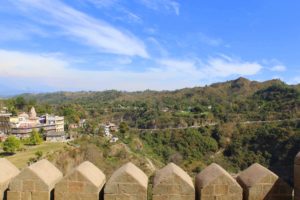
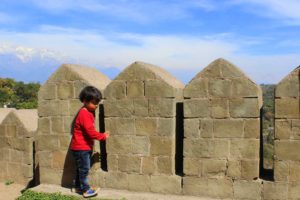
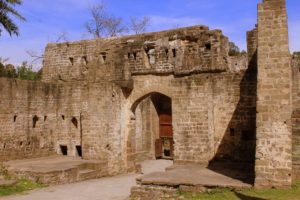
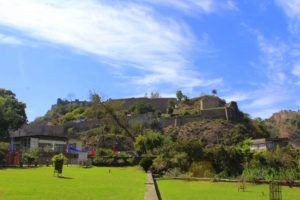
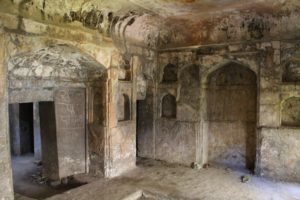
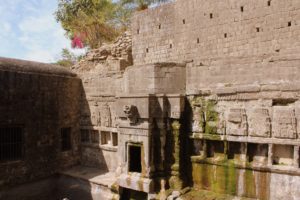
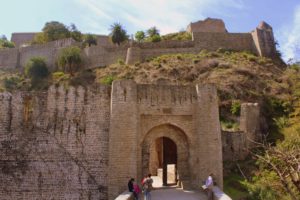
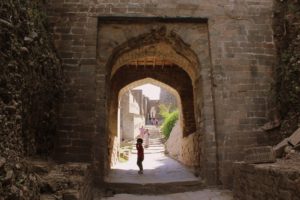
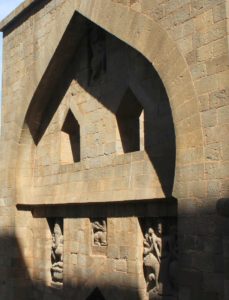
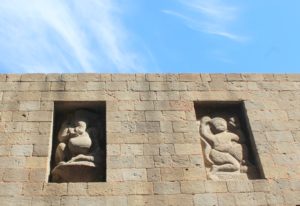
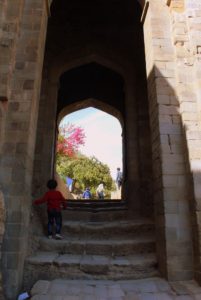
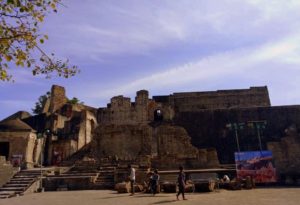
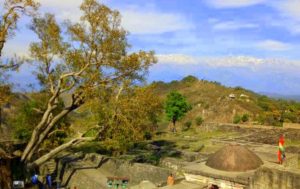
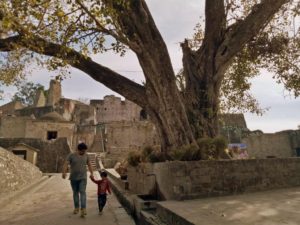
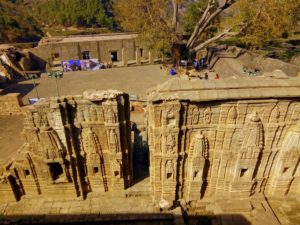
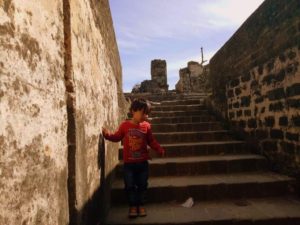
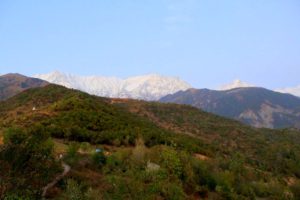
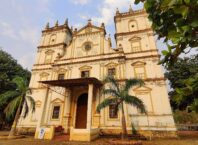
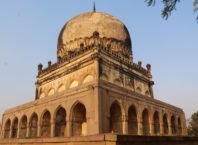
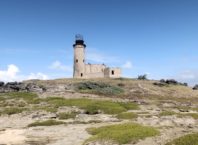








Nice Article, Keep posting same.
Himalaya Cab – Travel Safe, Travel Secure, Best taxi service in Dharamshala
Beautifully captured in pictures and words.
Dharamshala is just gorgeous. I have visited Kangra Fort, it packs a lot of history and stories behind it.
What an amazing beautiful place to visit. Love the photos.
Very interesting! I love the fact about the treasures! This would be something I would love to do, I can’t imagine all the history behind it. And I love the architecture, my daughter would love exploring it! It’s to bad that the 3 main temples are no longer there, but it would be interesting to see the one that still is.
What a beautiful place in Kangra Fort the views are totally incredible and perfect for a family trip I would love to visit this place someday awesome photos.
I would love to explore this fort. I love architecture.
In these times, when we can hardly leave Europe, showing these wonderful pictures is almost torture 😉 As soon as travel is possible again, I need to visit Himachal Pradesh!
Great to know that Kangra Fort has been renovated and so much has been restored so that more people can visit. Although it is sad to read that much of the site has been looted over the years. It certainly does provide an interesting mix of history and nature. In places it looks like nature tried to recapture the spot.
Such a pretty fort. Would definitely love to visit here
It looks like Kangra fort in Himachal Pradesh existed in the prehistoric ages. Beautifully built to attract tourist from different parts of the world.
What an incredible experience! I love your pictures and the history of each place. Thank you for sharing!
I was particularly intrigued by the history of the kangra fort. Thank you for educating me about this.
Amazing photos! This make me miss travelling . Well explained as well.
Very Nice Post